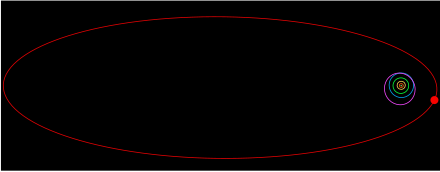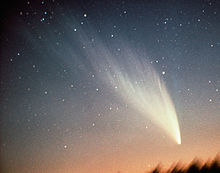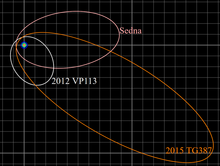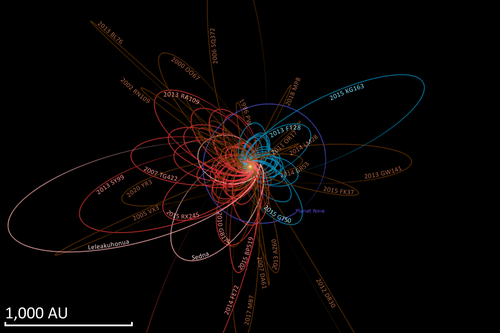| This article needs to be updated. Please help update this article to reflect recent events or newly available information. (January 2020) |

This is a list of Solar System objects by greatest aphelion or the greatest distance from the Sun that the orbit could take it if the Sun and object were the only objects in the universe. It is implied that the object is orbiting the Sun in a two-body solution without the influence of the planets, passing stars, or the galaxy. The aphelion can change significantly due to the gravitational influence of planets and other stars. Most of these objects are comets on a calculated path and may not be directly observable. For instance, comet Hale-Bopp was last seen in 2013 at magnitude 24 and continues to fade, making it invisible to all but the most powerful telescopes.
The maximum extent of the region in which the Sun's gravitational field is dominant, the Hill sphere, may extend to 230,000 astronomical units (3.6 light-years) as calculated in the 1960s. But any comet currently more than about 150,000 AU (2 ly) from the Sun can be considered lost to the interstellar medium. The nearest known star is Proxima Centauri at 269,000 AU (4.25 ly), followed by Alpha Centauri at about 4.35 light years.
Oort cloud comets orbit the Sun at great distances, but can then be perturbed by passing stars and the galactic tides. As they come into or leave the inner Solar System they may have their orbit changed by the planets, or alternatively be ejected from the Solar System. It is also possible they may collide with the Sun or a planet.
S/2021 N 1 (the outermost moon of Neptune) takes over 27 years to orbit Neptune, comets can take up to 30 million years to orbit the Sun, and the Sun orbits the Milky Way in about 230 million years (a galactic year).
| Satellite | Orbital period (years) |
Parent body | Percentage of parent body orbital period |
|---|---|---|---|
| S/2021 N 1 | 27.4 | Neptune | 16.6% |
| Oort cloud comet | 30 million | Sun | 13% |
| Sun | 230 million | Milky Way | N/A |
Explanation
Barycentric vs heliocentric orbits

As many of the objects listed below have some of the most extreme orbits of any objects in the Solar System, describing their orbit precisely can be particularly difficult and sensitive to the time the orbit is defined at. For most objects in the Solar System, a heliocentric reference frame (relative to the gravitational center of the Sun) is sufficient to explain their orbits. However, as the orbits of objects become closer to the Solar System's escape velocity, with long orbital periods on the order of hundreds or thousands of years, a different reference frame is required to describe their orbit: a barycentric reference frame. A barycentric reference frame measures the asteroid's orbit relative to the gravitational center of the entire Solar System, rather than just the Sun. Mostly due to the influence of the outer gas giants, the Solar System barycenter varies by up to twice the radius of the Sun.
This difference in position can lead to significant changes in the orbits of long-period comets and distant asteroids. Many comets have hyperbolic (unbound) orbits in a heliocentric reference frame, but in a barycentric reference frame have much more firmly bound orbits, with only a small handful remaining truly hyperbolic.
Eccentricity and Vinf
The orbital parameter used to describe how non-circular an object's orbit is, is eccentricity (e). An object with an e of 0 has a perfectly circular orbit, with its perihelion distance being just as close to the Sun as its aphelion distance. An object with an e of between 0 and 1 will have an elliptical orbit, with, for instance, an object with an e of 0.5 having a perihelion twice as close to the Sun as its aphelion. As an object's e approaches 1, its orbit will be more and more elongated before, and at e=1, the object's orbit will be parabolic and unbound to the Solar System (i.e. not returning for another orbit). An e greater than 1 will be hyperbolic and still be unbound to the Solar System.
Although it describes how "unbound" an object's orbit is, eccentricity does not necessarily reflect how high an incoming velocity said object had before entering the Solar System (a parameter known as Vinfinity, or Vinf). A clear example of this is the eccentricities of the two known Interstellar objects as of October 2019, 1I/'Oumuamua. and 2I/Borisov. 'Oumuamua had an incoming Vinf of 26.5 kilometres per second (59,000 mph), but due to its low perihelion distance of only 0.255 au, it had an eccentricity of 1.200. However, Borisov's Vinf was only slightly higher, at 32.3 km/s (72,000 mph), but due to its higher perihelion distance of ~2.003 au, its eccentricity was a comparably higher 3.340. In practice, no object originating from the Solar System should have an incoming heliocentric eccentricity much higher than 1, and should rarely have an incoming barycentric eccentricity of above 1, as that would imply that the object had originated from an indefinitely far distance from the Sun.
Orbital epochs
Due to having the most eccentric orbits of any Solar System body, a comet's orbit typically intersects one or more of the planets in the Solar System. As a result, the orbit of a comet is frequently perturbed significantly, even over the course of a single pass through the inner Solar System. Due to the changing orbit, it's necessary to provide a calculation of the orbit of the comet (or similarly orbiting body) both before and after entering the inner Solar System. For example, Comet ISON was ~312 au from the Sun in 1600, and its remnants will be ~431 au from the Sun in 2400, both well outside of any significant gravitational influence from the planets.
Comets with greatest aphelion (2 body heliocentric)


| Object | Heliocentric Aphelion (Q) (Sun) Perihelion epoch |
Barycentric Aphelion (AD) (Sun+Jupiter) epoch 2200 |
Barycentric Aphelion epoch 1800 |
|---|---|---|---|
| C/2004 R2 (ASAS) | 3,238,164 AU (51 ly) | 13000 AU | 4000 AU |
| C/2015 O1 (PANSTARRS) | 1,302,400 AU (21 ly) | 15000 AU | 60000 AU |
| C/2012 S4 (PANSTARRS) | 504,443 AU (8.0 ly) | 5700 AU | 8400 AU |
| C/2012 CH17 (MOSS) | 279,825 AU (4.4 ly) | 7283 AU | 26000 AU |
| C/2008 C1 (Chen-Gao) | 203,253 AU (3.2 ly) | 3822 AU | 520 AU |
| C/1992 J1 (Spacewatch) | 226,867 AU (3.6 ly) | 3700 AU | 75000 AU |
| C/2007 N3 (Lulin) | 144,828 AU (2.3 ly) | 2419 AU | 64000 AU |
| C/2017 T2 (PANSTARRS) | 117,212 AU (1.9 ly) | 2975 AU | 84000 AU |
| C/1937 N1 (Finsler) | 115,031 AU (1.8 ly) | 7121 AU | 16000 AU |
| C/1972 X1 (Araya) | 108,011 AU (1.7 ly) | 5630 AU | 4200 AU |
| C/2014 R3 (PANSTARRS) | 80,260 AU (1.3 ly) | 12841 AU | 19000 AU |
| C/2015 O1 (PANSTARRS) | 77,092 AU (1.2 ly) | 21753 AU | 52000 AU |
| C/2001 C1 (LINEAR) | 76,230 AU (1.2 ly) | ejection | 98000 AU |
| C/2002 J4 (NEAT) | 57,793 AU (0.91 ly) | ejection | 59000 AU |
| C/1958 D1 (Burnham) | 46,408 AU (0.73 ly) | 1110 AU | 7800 AU |
| C/1986 V1 (Sorrells) | 37,825 AU (0.60 ly) | 8946 AU | 5400 AU |
| C/2005 G1 (LINEAR) | 37,498 AU (0.59 ly) | 40572 AU | 110000 AU |
| C/2006 W3 (Christensen) | 35,975 AU (0.57 ly) | 8212 AU | 5300 AU |
| C/2009 W2 (Boattini) | 31,059 AU (0.49 ly) | 3847 AU | 4200 AU |
| C/2005 L3 (McNaught) | 26,779 AU (0.42 ly) | 6851 AU | 33000 AU |
| C/2004 YJ35 (LINEAR) | 26,433 AU (0.42 ly) | 2480 AU | 75000 AU |
| C/2003 H3 (NEAT) | 26,340 AU (0.42 ly) | ejection | 4900 AU |
| C/2010 L3 (Catalina) | 25,609 AU (0.40 ly) | 21094 AU | 12000 AU |
| C/1902 R1 (Perrine) | 25,066 AU (0.40 ly) | 2306 AU | 74000 AU |
| C/1889 G1 (Barnard) | 24,784 AU (0.39 ly) | 1575 AU | 2100 AU |
| C/2007 VO53 (Spacewatch) | 24,383 AU (0.39 ly) | 16835 AU | 22000 AU |
Distant comets with long observation arcs and/or barycentric

Examples of comets with a more well-determined orbit. Comets are extremely small relative to other bodies and hard to observe once they stop outgassing (see Coma (cometary)). Because they are typically discovered close to the Sun, it will take some time even thousands of years for them to actually travel out to great distances. The Whipple proposal might be able to detect Oort cloud objects at great distances, but probably not a particular object.
- Comet West 70,000 AU (1.1 light-years)
- C/1999 F1 (Catalina) 66,600 AU (1.05 light-years)
- C/2012 S4 (PANSTARRS) 5700 AU (barycentric)
- Comet Hyakutake (C/1996 B2) 3410 AU
- C/1910 A1 (Great January comet) about 2974 AU (barycentric)
- C/1992 J1 (Spacewatch) 3650 AU
- C/2007 N3 (Lulin) 2400 AU
Minor planets
See also: List of trans-Neptunian objects and List of Solar System objects most distant from the Sun| Aphelion in AU |
Number of minor planets |
|---|---|
| 400-800 | 36 |
| 800-1200 | 15 |
| 1200-1600 | 7 |
| 1600-2000 | 4 |
| 2000-2400 | 5 |
| 2400-2800 | 2 |
| 2800+ | 3 |
A large number of trans-Neptunian objects (TNOs) – minor planets orbiting beyond the orbit of Neptune – have been discovered in recent years. Many TNOs have orbits that take them far beyond Pluto's aphelion of 49.3 AU. Some of these TNOs with an extreme aphelion are detached objects such as 2010 GB174, which always reside in the outermost region of the Solar System, while for other TNOs, the extreme aphelion is due to an exceptionally high eccentricity such as for 2005 VX3, which orbits the Sun at a distance between 4.1 (closer than Jupiter) and 2200 AU (70 times farther from the Sun than Neptune). The following is a list of minor planets with the largest aphelion in descending order.
Minor planets with a heliocentric aphelion greater than 400 AU
The following group of bodies have orbits with an aphelion above 400 AU, with 1-sigma uncertainties given to two significant digits. As of May 2024, there are 73 such bodies.

| Object | Aphelion (AU) | Absolute Magnitude (H) | Ref |
|---|---|---|---|
| A/2020 M4 | 29020.06 ±420 | 14.01 ±0.28 | MPC · JPL |
| 2010 LN135 | 20162.05 ±6000 | 14.08 | MPC · JPL |
| A/2024 D1 | 3875.88 ±2456 | 11.45 ±0.52 | MPC · JPL |
| 2014 FE72 | 3559.58 ±220 | 6.19 | MPC · JPL |
| 541132 Leleākūhonua | 2713.25 ±360 | 5.57 ±0.13 | MPC · JPL |
| 2017 MB7 | 2419.67 ±320 | 14.21 ±0.33 | MPC · JPL |
| 2021 RR205 | 2314.82 ±51 | 6.74±0.12 | MPC · JPL |
| 2013 BL76 | 2261.12 ±2.4 | 10.88 | MPC · JPL |
| A/2019 N2 | 2115.35 ±690 | 12.80±0.43 | MPC · JPL |
| 2019 EU5 | 2108.10 ±450 | 6.35 ±0.14 | MPC · JPL |
| (308933) 2006 SQ372 | 2062.42 ±1.6 | 7.94 | MPC · JPL |
| A/2022 B3 | 1957.25 ±11 | 16.56 ±0.76 | MPC · JPL |
| (668643) 2012 DR30 | 1877.78 ±1.3 | 7.12 | MPC · JPL |
| 2013 SY99 | 1718.93 ±50 | 6.84 | MPC · JPL |
| 2005 VX3 | 1717.16 ±300 | 14.10 | MPC · JPL |
| 2021 DK18 | 1418.77 ±320 | 6.72 ±0.24 | MPC · JPL |
| A/2019 G2 | 1397.41 ±1.7 | 16.31 ±0.55 | MPC · JPL |
| A/2021 E4 | 1388.62 ±1.2 | 14.26 ±0.45 | MPC · JPL |
| A/2018 W3 | 1341.59 ±10 | 10.70 ±0.29 | MPC · JPL |
| (87269) 2000 OO67 | 1326.78 ±0.76 | 9.10 | MPC · JPL |
| 2002 RN109 | 1295.34 ±51 | 15.30 | MPC · JPL |
| 2015 KG163 | 1241.82 ±7.2 | 8.20 | MPC · JPL |
| (523622) 2007 TG422 | 1118.81 ±0.64 | 6.47 | MPC · JPL |
| 2015 SA57 | 1052.34 ±0.51 | 9.92 ±0.37 | MPC · JPL |
| 2013 GW141 | 1032.63 ±0.62 | 8.16 ±0.35 | MPC · JPL |
| 2012 KA51 | 1015.61 ±9.9 | 11.74 ±0.79 | MPC · JPL |
| 2013 RA109 | 1008.19 ±2.7 | 6.23 ±0.22 | MPC · JPL |
| 90377 Sedna (2003 VB12) | 1006.90±2.7 | 1.50 | MPC · JPL |
| 2020 QN6 | 990.67 ±0.62 | 14.55 ±0.37 | MPC · JPL |
| 2014 GQ101 | 986.20 ±0.37 | 10.56 ±0.43 | MPC · JPL |
| 2015 BP519 | 933.55 ±2.5 | 4.34 | MPC · JPL |
| 2015 RX245 | 888.63 ±8.1 | 6.20 | MPC · JPL |
| 2015 AD298 | 859.76 ±4.7 | 8.38 ±0.52 | MPC · JPL |
| 2015 FK37 | 853.72 ±1.7 | 14.50 ±0.26 | MPC · JPL |
| 2020 YR3 | 846.98 ±0.49 | 9.30 ±0.42 | MPC · JPL |
| 2010 BK118 | 828.61 ±0.46 | 10.30 | MPC · JPL |
| 2007 DA61 | 816.45 ±11 | 14.90 ±0.47 | MPC · JPL |
| 2013 RF98 | 776.26 ±30 | 8.70 | MPC · JPL |
| 2014 SX403 | 773.46 ±4.1 | 7.06 ±0.32 | MPC · JPL |
| (418993) 2009 MS9 | 767.45 ±0.085 | 9.74 | MPC · JPL |
| 2013 AZ60 | 762.63 ±0.1 | 10.30 | MPC · JPL |
| 2014 RK86 | 753.12 ±16 | 8.22 ±0.31 | MPC · JPL |
| 2018 MP8 | 732.44 ±7.7 | 15.30 | MPC · JPL |
| 2016 SD106 | 731.06±7.6 | 6.70 ±0.33 | MPC · JPL |
| 2014 TU115 | 704.80 ±2.0 | 7.86 ±0.44 | MPC · JPL |
| 2021 CP5 | 689.35±0.57 | 12.23 ±0.41 | MPC · JPL |
| 2022 LO17 | 684.64 ±270000 | 8.52 ±0.10 | MPC · JPL |
| A/2020 H9 | 680.42 ±1.1 | 17.70 ±0.34 | MPC · JPL |
| 474640 Alicanto | 663.36 ±2.3 | 6.46 | MPC · JPL |
| 2013 SL102 | 653.9 ±0.91 | 7.13 ±0.33 | MPC · JPL |
| 2017 UR52 | 650.82 ±140 | 21.20 | MPC · JPL |
| (689335) 2013 FL28 | 648.32 ±0.27 | 8.07 ±0.44 | MPC · JPL |
| 2021 PN72 | 637.57 ±0.22 | 12.04 ±0.18 | MPC · JPL |
| 2010 GB174 | 630.26 ±14 | 6.74 | MPC · JPL |
| 2014 SR349 | 601.90 ±2.4 | 6.46 | MPC · JPL |
| 2011 OR17 | 579.67 ±0.35 | 13.10 | MPC · JPL |
| (336756) 2010 NV1 | 570.60 ±0.17 | 10.55 | MPC · JPL |
| 2014 WB556 | 560.73 ±1.2 | 7.26 ±0.27 | MPC · JPL |
| 2015 GT50 | 554.67 ±4.5 | 8.50 | MPC · JPL |
| 1996 PW | 552.06 ±0.56 | 13.90 | MPC · JPL |
| 2018 VM35 | 545.94 ±34 | 7.76 ±0.05 | MPC · JPL |
| (523719) 2014 LM28 | 543.67 ±0.15 | 9.95 | MPC · JPL |
| 2013 FT28 | 519.49 ±2.7 | 7.20 | MPC · JPL |
| 2017 SN33 | 511.63 ±16 | 17.90 | MPC · JPL |
| 2015 DM319 | 505.11 ±2.3 | 8.78 ±0.11 | MPC · JPL |
| 2016 SA59 | 484.56 ±1.2 | 7.81 ±0.36 | MPC · JPL |
| (582301) 2015 RM306 | 480.63 ±0.028 | 11.06 ±0.44 | MPC · JPL |
| 2012 VP113 | 467.17 ±0.99 | 4.09 | MPC · JPL |
| 2016 SG58 | 464.64±0.39 | 7.50 ±0.41 | MPC · JPL |
| 2015 RY245 | 449.66 ±9.0 | 8.90 | MPC · JPL |
| A/2021 E2 | 430.46 ±8.3 | 17.90 ±0.44 | MPC · JPL |
| 2014 QW510 | 411.63 ±0.32 | 7.53 ±0.24 | MPC · JPL |
| (148209) 2000 CR105 | 400.29 ±1.2 | 6.14 | MPC · JPL |
Greatest barycentric aphelion
The following asteroids have an incoming barycentric aphelion of at least 1000 AU.
| name | diameter (km) (assumed) | perihelion (AU) | Barycentric aphelion (AU) (1800) | Barycentric aphelion (AU) (2200) | Change (%) |
|---|---|---|---|---|---|
| A/2020 M4 | 5.2 | 5.95 | 5580 | 4500 | -24 |
| 2014 FE72 | 206.8 | 36.33 | 3071 | 3060 | -0.36 |
| 2002 RN109 | 3.0 | 2.691 | 2320 | 1190 | -49 |
| 2005 VX3 | 5.2 | 4.106 | 2140 | 1700 | -21 |
| 541132 Leleākūhonua | 272.6 | 65.08 | 2280 | 2280 | 0 |
| A/2022 B3 | 1.9 | 3.708 | 2100 | 2540 | +21 |
| 2017 MB7 | 5.2 | 4.456 | 2040 | 2840 | +28 |
| (668643) 2012 DR30 | 130.5 | 14.57 | 2000 | 2050 | +2.4 |
| 2013 BL76 | 23.7 | 8.355 | 1850 | 1920 | +3.6 |
| (308933) 2006 SQ372 | 94.5 | 24.14 | 1540 | 1560 | +1.3 |
| 2013 SY99 | 156.8 | 50.03 | 1410 | 1410 | 0 |
| 2015 KG163 | 78.6 | 40.50 | 1320 | 1320 | 0 |
| 2013 AZ60 | 29.9 | 7.927 | 1260 | 827 | -34 |
| 2007 DA61 | 3.6 | 2.677 | 1190 | 852 | -28 |
| 2013 GW141 | 78.6 | 23.52 | 1130 | 1120 | -0.9 |
| (87269) 2000 OO67 | 49.6 | 20.73 | 1120 | 1070 | -4.5 |
Comparison

See also
- List of trans-Neptunian objects (numbered minor planets only)
- List of unnumbered trans-Neptunian objects
- List of artificial objects leaving the Solar System
- List of Solar System objects most distant from the Sun (then-year distance from the Sun)
- List of nearest stars and brown dwarfs
- List of the most distant astronomical objects
- About comets
- List of hyperbolic comets
- List of comets with no meaningful orbit
- List of near-parabolic comets
- List of periodic comets
- List of numbered comets
- Interstellar object
- Objects of interest
- Others
- Oort cloud – Distant planetesimals in the Solar System
- Kuiper belt – Area of the Solar System beyond the planets, comprising small bodies
- Sednoid – Group of Trans-Neptunian objects
- Detached object – Dynamical class of minor planets
References
- ^ JPL Small-Body Database Search Engine: Q > 20000 (au)
- "C/1995 O1 (Hale-Bopp)". Minor Planet Center. Retrieved 14 March 2018.
- Chebotarev, G.A. (1964), "Gravitational Spheres of the Major Planets, Moon and Sun", Soviet Astronomy, 7 (5): 618–622, Bibcode:1964SvA.....7..618C
- ^ NASA – Imagine the Universe: The Nearest Star
- ^ Frequently Asked Questions About General Astronomy
- Barycentric solution for 2004 R2
- Barycentric solution for 2015 O1
- Barycentric solution for 2012 S4
- Horizons output. "Barycentric Osculating Orbital Elements for Comet C/1975 V1-A (West)". Retrieved 2011-02-01. (Solution using the Solar System Barycenter. Select Ephemeris Type:Elements and Center:@0)
- Horizons output. "Barycentric Osculating Orbital Elements for Comet C/1999 F1 (Catalina)". Retrieved 2011-03-07. (Solution using the Solar System Barycenter and barycentric coordinates. Select Ephemeris Type:Elements and Center:@0)
- Horizons output. "Barycentric Osculating Orbital Elements for Comet C/2012 S4 (PANSTARRS)". Retrieved 2015-09-26. (Solution using the Solar System Barycenter and barycentric coordinates. Select Ephemeris Type:Elements and Center:@0)
- Horizons output (2011-01-30). "Barycentric Osculating Orbital Elements for Comet Hyakutake (C/1996 B2)". Retrieved 2011-01-30. (Horizons)
- Horizons output. "Barycentric Osculating Orbital Elements for Comet C/1910 A1 (Great January comet)". Retrieved 2011-02-07. (Solution using the Solar System Barycenter and barycentric coordinates. Select Ephemeris Type:Elements and Center:@0)
- Horizons output. "Barycentric Osculating Orbital Elements for Comet C/1992 J1 (Spacewatch)". Retrieved 7 October 2012. (Solution using the Solar System Barycenter and barycentric coordinates. Select Ephemeris Type:Elements and Center:@0)
- Horizons output. "Barycentric Osculating Orbital Elements for Comet Lulin (C/2007 N3)". Retrieved 2011-01-30. (Solution using the Solar System Barycenter. Select Ephemeris Type:Elements and Center:@0)
- ^ "Small-Body Database Query". ssd.jpl.nasa.gov. Retrieved 2024-05-09.
External links
- A distant planet may lurk far beyond Neptune
- Mysterious Planet X May Really Lurk Undiscovered in Our Solar System